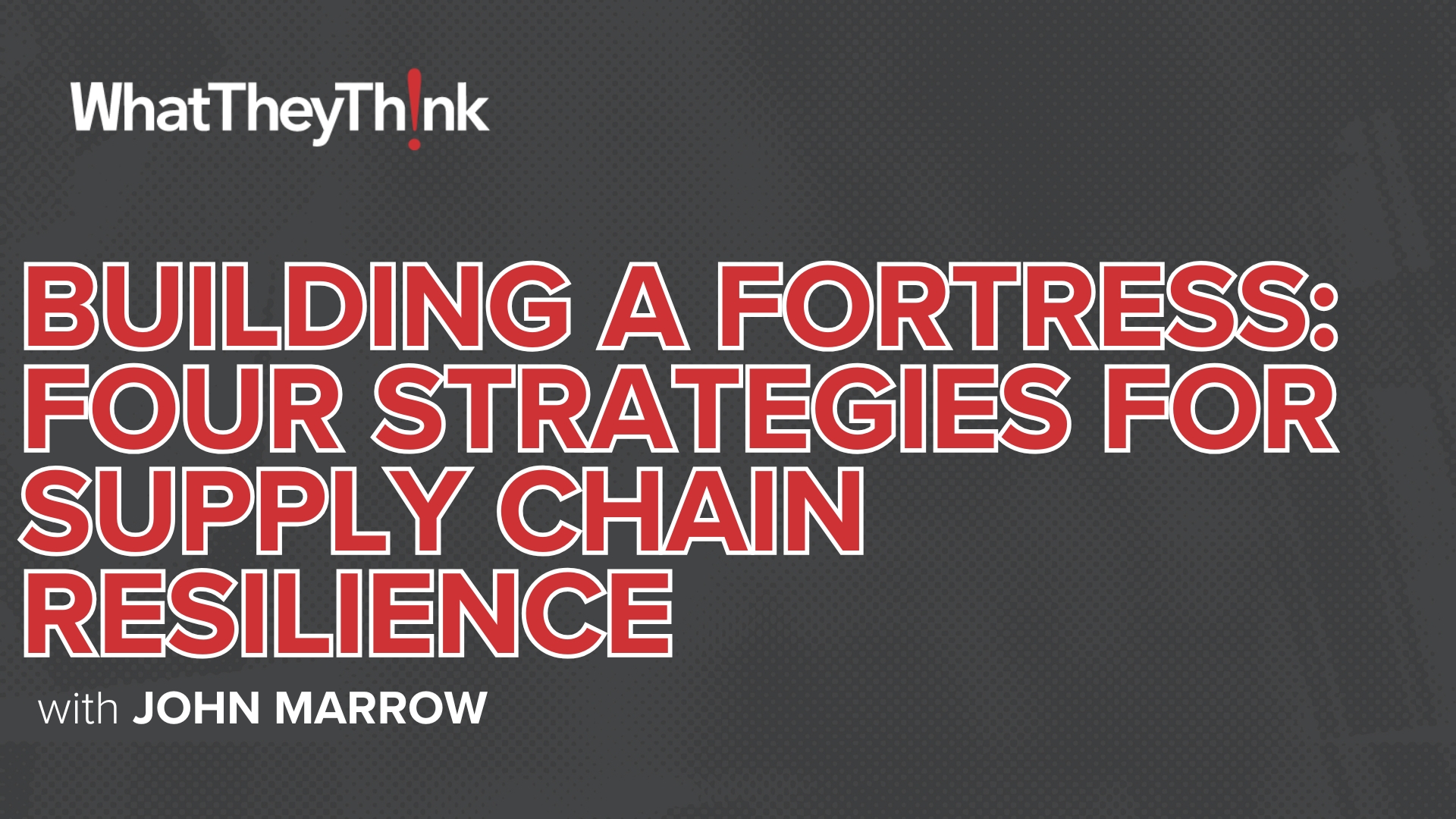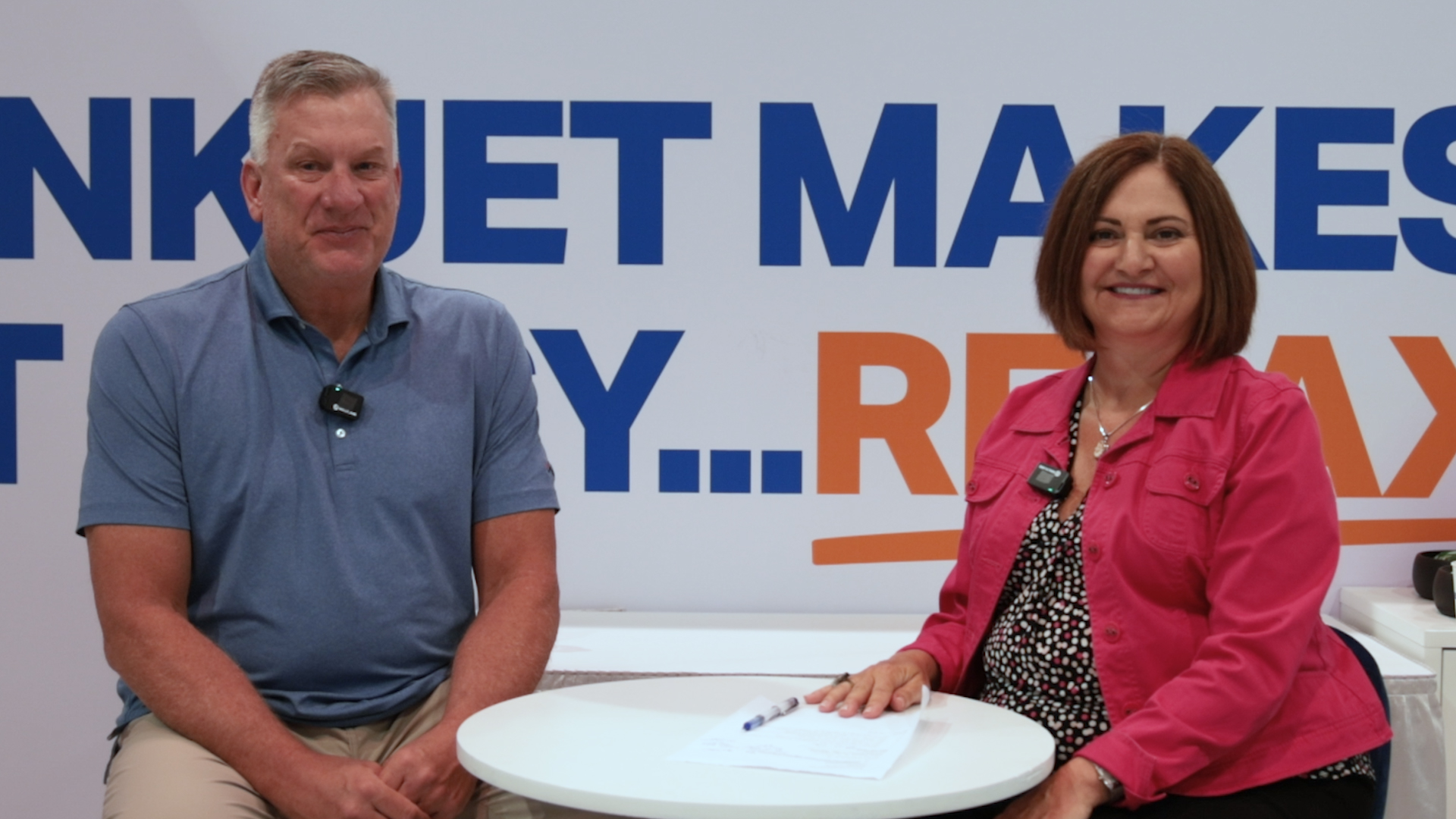Commentary & Analysis
Displaying 800-899 of thousands of articles
Insight You Need. Analysis You Trust.
Get the trusted insights you need to understand our evolving industry and emerging trends. Become a Premium Member.
Print Volume Trends in Sheetfed and Continuous Feed Inkjet
Three weeks ago, as part of WhatTheyThink’s fourth annual Technology Outlook Week, our five-day series of webinars that look at the latest trends and technologies in a broad cross-section of the industry, Ralf Schlözer took a look at digital printing. In part two of her coverage of this session, Heidi Tolliver-Walker sums up the discussion of print volumes.
ICYMI: Zen and the Art of Software Maintenance
At its essence, software is a tool that is based in science, but has artistic manifestations. The style of coding, the elegance of programming expression, and the user interfaces that join the user to the software capabilities create a yin/yang relationship. Software does require care and feed, however. Here is some guidance on living with software, whether it was created in your shop, downloaded for free, or purchased from a vendor!
The Production Inkjet Evolution: Canon Production Cut-Sheet Inkjet
In 2011, I began a series that looked at the then-current production inkjet vendor product offerings, and over the years continued to look at how they were being, or could be, used. In this new series, 15 years later and with drupa 2024 on the horizon, it’s time to take a look at how production inkjet has evolved, how it is used, and where we can expect it to go and grow. I will look at each of the production inkjet manufacturers and suppliers and customers and document some of their journeys. In this article, I look at Canon cut-sheet production inkjet.
Here Come the Robots—News and Trends from FESPA 2023
The FESPA Global Print Expo was held in Münich, Germany, May 23 to 26. WhatTheyThink European section editor Ralf Schlözer attended and identifies some highlights from the show.
ITMA 2023: The Highlights
ITMA, the International Textile Machinery Association, opened the doors for its quadrennial show in Milan, running from June 8 to 14. Owned by CEMATEX and organized by ITMA, this edition is focused on “Transforming the World of Textiles.” For those of you in the printing industry who may not be familiar with ITMA, it’s the drupa of the textiles industry. In this article, we present some of the show highlights as of this writing. Stay tuned for more!
Tech Outlook: Finishing Roundup
Last month, as part of WhatTheyThink’s fourth annual Technology Outlook Week, our five-day series of webinars that look at the latest trends and technologies in a broad cross-section of the industry, Trish Witkowski and Kevin Abergel looked at the latest products, technologies, and trends in binding and finishing. In this article, Heidi Tolliver-Walker recaps the webinar.
Johnson’s World—You Have Mail…Or Maybe Not
By law, the US Postal Service is supposed to deliver mail six days a week. Steve Johnson tries to understand why his mail delivery has become erratic and unreliable.
Printing Pulse: Embellishment Edition
This edition of our Friday data series offers a preliminary “sneak peek” at the results of the Taktiful and WhatTheyThink 2023 Specialty Digital Ink and Toner Embellishment Study. This study takes a deep dive into how current users of digital ink and toner embellishment technologies are utilizing them, what the response from customers has been, how satisfied print providers have been with the sales and profitability of these jobs, where the challenges lie, and their general feelings about the future of digital ink and toner embellishment technologies.
Around the Web: Ledger Lines. Typewriter Tunes. Graphene Garments. Pink Paucity. Plate Problem. Sadistic Subscriptions. Block Clock. Panel Panic. Baneful Bot.
A look at how they used to print ledger books. The Boston Typewriter Orchestra performs on NPR’s Tiny Desk Concert. Absolut is introducing lightweight paper-based bottles for its vodka. Another leap forward for graphene-based wearable textiles. The “Barbie” movie caused a shortage of pink paint. Some Maryland license plates contain a link to a Philippine gambling site. Thanks to the “aaS” model, we don’t really own anything anymore. A solar-powered mechanical LEGO clock that will keep time for a billion years. The time has come to address the imminent deluge of discarded solar panels. Can experts really judge wine? A pop-up Cheez-It filling station in Joshua Tree National Park. All that and more in WhatTheyThink’s weekly miscellany.
The Target Report: The Party is Over at Vice Media, and Why it Matters—May 2023 M&A Activity
Vice Media Files Bankruptcy, and more …
What’s Old Is New Again: Will Paper Really Replace Film in Flexible Packaging? The Future Borrows from the Past for Some Exciting New Ideas
With the increased scrutiny of plastic use in flexible packaging, there is an increased interest in moving from plastic to paper. It was once hard to make the switch, but it has been getting much easier.
Razzle Dazzle: User Success Stories on Creating Memorable Tactile Experiences
Taktiful’s Kevin Abergel talks to three US print service providers that have successfully won over customers after installing digital embellishment production systems.
Solutum Offers a New Approach to Reducing Plastic Waste
Solutum is a Cleantech company on a mission to reduce plastic pollution by providing sustainable alternatives to single-use plastic. The company has created a revolutionary compound that can be engineered to create a range of flexible packaging with versatile end-of-life options. Cary Sherburne talks to Sharon Barak, the company’s Founder and CTO, to learn more about this innovative approach to solving the plastics problem.
Kyocera FOREARTH Digital Textile Printer Debuts at ITMA
Kyocera printheads are popular components in many digital textile printing systems. Now, Kyocera has applied that knowledge and expertise to its first digital textile printer, FOREARTH, making its first public appearance at ITMA in Milan. In this interview, Sho Taniguchi, Kyocera’s Deputy General Manager, IDP Business DevelopmentDivision, explains the strategy behind development of this system and why they believe it is beneficial to the textiles market.
You’ve Got Mail: Mailing Technology Continues to Revolutionize Direct-Mail Marketing
Today’s mail technology enables campaigns that are truly cutting edge, and that edge is getting sharper. We’ve barely scratched the surface of what can be done with personalized, customized messaging printed on the outside of the envelopes. Heidi-Tolliver Walker takes a look at the current state of the art.
Is There a Robot in Your Future?
Levi’s turns 170 this year, but it’s not letting its age get in the way of its innovation. The company reports that it has allocated 25,000 hours to a team of in-house robots over the past year. These robots, though, are not replacing employees. Rather, they are making work more efficient and enjoyable by freeing employees from performing a number of often repetitive and tedious tasks, and making more time for them to focus on more strategic activities. And Levi’s isn’t alone in harnessing the power of robots to make work more efficient. Here’s a quick pre-ITMA view of robotics in textiles, with more to certainly come from the world’s largest textile industry trade show, this week in Milan.
Tech Outlook: Packaging
Two weeks ago, as part of WhatTheyThink’s fourth annual Technology Outlook Week, our five-day series of webinars that look at the latest trends and technologies in a broad cross-section of the industry, David Zwang took a look at labels and packaging. In this article, Heidi Tolliver-Walker recaps the webinar.
Crawl, Walk, Run—Enter the Embellishment World at Your Own Pace
Trish Witkowski takes a deep dive into the hardware available for adding embellishments, be they analog or digital. She runs down the top technologies, and identifies specific equipment at the entry level, mid-range, and high end of the market for each technology.
Artful Adaptations: Matt Redbear Is No Stranger to Changing Technology and How to Use It to His Advantage
WhatTheyThink Multimedia Production Editor Jessica Taylor profiles Matt Redbear, creative director for Taktiful, and talks about how he used AI to come up with the cover for the most recent (Issue 3) print edition of WhatTheyThink.
The Whole Package: How to Turn a Product into a Purchase by Appealing to a Consumer’s Senses
David Zwang provides a primer on embellishment technologies for packaging applications—including why they are becoming more important than ever for brands.
Tech Outlook: A Framework for Automation
Two weeks ago, as part of WhatTheyThink’s fourth annual Technology Outlook Week, our five-day series of webinars that look at the latest trends and technologies in a broad cross-section of the industry, Pat McGrew and Ryan McAbee took a look at software and workflow—specifically addressing automation. In this article, Heidi Tolliver-Walker recaps the webinar.
The Rise of Sexy Print: Digital Embellishments Are Revolutionizing Ink on Paper, Creating New Opportunities for Marketers and Brands
Digital embellishments allow brands to create visually stunning packaging and labels, with intricate designs otherwise difficult or impossible to achieve affordably with traditional printing methods. Joanne Gore looks at the current lay of the land.
Talkin’ ’Bout My Generation
The USPS conducted the “Generational Research Report,” which shows who’s reading what and what elements of direct mail are most important to which generations. Think of it as that generation’s direct mail fingerprint. Heidi Tolliver-Walker offers some highlights.
From Display Graphics to Graphic Tees: Already Print Soft Signage? Why Not Add Garment Printing?
As commercial printers, in-plants, and sign and display graphics printers look for ways to expand their businesses and offer new products and services to their customers, expansion into the textiles industry looks like an interesting opportunity. Cary Sherburne explains how.
Technology Outlook: Digital Printing
Two weeks ago, as part of WhatTheyThink’s fourth annual Technology Outlook Week, our five-day series of webinars that look at the latest trends and technologies in a broad cross-section of the industry, Ralf Schlözer took a look at digital printing. In this article, Heidi Tolliver-Walker recaps the webinar.
Paperboard Container Shipments Back up to Pandemic Levels
In March 2023, the value of shipments of paperboard containers was $6.361 billion, the highest it has been since August 2022.
Around the Web: Creative Contents. Letterpress Love. Pedestrian Pals. Creepy Closure. Lighthouse Living. Graphene Gaming. Skin Solution. Winging Weight. Hellish Hammer.
Experimental tables of contents. 105-year-old Bay View Printing still prints on century-old letterpress equipment. LA’s “crosswalk vigilantes” help improve pedestrian safety. “Séance AI” for one last chat with the departed. The US Government is auctioning off lighthouses—some for free. Artificial “e-skin” can communicate with the brain. An Indian food inspector drains a reservoir to retrieve his phone. New Zealand Air to start weighing passengers for “data collection purposes.” The “Hammer Fist” is a bizarre tool. Plastic wine bottles are on their way. All that and more in WhatTheyThink’s weekly miscellany.
ICYMI: FESPA 2023 Review: New Tech, Trends, and Key Market Shifts—A Powerful and Successful Show for the Global Print Community
From DTG & DTF to screen printing and from digital inks to consumables, the scope of innovation was evident to all attendees who showed great interest in the 70+ new product launches at FESPA. In this article, textiles expert and WhatTheyThink contributor Debbie McKeegan offers some highlights of the most notable unveilings that took place at this global show.
Technology Outlook: Wide Format and Signage
Last week, as part of WhatTheyThink’s fourth annual Technology Outlook Week, our five-day series of webinars that look at the latest trends and technologies in a broad cross-section of the industry, Richard Romano and Cary Sherburne tag-teamed a look at wide-format and signage and textiles and apparel. This article recaps the wide-format portion of the webinar
“Soon to Be Unveiled” Functionality Will Let Printers Integrate Directly with Salesforce, HubSpot, and Other Marketing Automation Platforms
One of the missing pieces in print marketing automation has been the ability for printers to integrate with their customers through platforms like Salesforce, HubSpot, and Zapier. Heidi Tolliver-Walker teases a forthcoming solution that will allow printers and clients to work together directly.
Productivity Improvement Options
This article is the third in the series on how to incorporate productivity improvement into your growth strategies for the foreseeable future. What approaches to improvement should you consider? This article has a list of five general groupings of ideas and recommendations. Hopefully, it will prompt the reader to generate even more. Building on a long-running theme, we continue to emphasize that improving the personal effectiveness of employees and improving business productivity overlap and work together. Half of the ideas listed touch on various aspects of what that entails.
Fighting Deforestation by Tracking Print
The European Union is introducing a regulation on deforestation-free products as part of the European Green Deal. European section editor Ralf Schlözer digs into what the new rules mean for printers.
AI Is Here! Fire Everybody?
Welcome to the rise of the robots—or at least chatbots! Businesses in every segment are looking at how artificial intelligence can help them grow. The anecdotes are becoming part of the mainstream—eliminating staff positions and replacing them with chatbots is a common theme. That begs the question: what happens if you fire everybody and let the bots do the work? Let’s explore that.
Paper Bag and Coated and Treated Paper Manufacturing Establishments—2010–2020
According to County Business Patterns, in 2020 there were 723 establishments in NAICS 32222 (Paper Bag and Coated and Treated Paper Manufacturing). This category saw a net decrease in establishments of -12% since 2010. In macro news, the Architecture Billings Index suggests a recovery from the slowdown in the construction industry.
Around the Web: Hefty Hitchhikers. Code Cooling. Dot Displays. Wedding Wear. Graphene Griddle. New Nova. Ring Removal. Cat Commerce. Custom Ketchup.
A special print edition of The Hitchhikers Guide to the Galaxy five-book trilogy is on the way. QR codes just aren’t cool any more, a least in restaurants. William A. Lavalette, an obscure 19th-century Black inventor, received two printing press-related patents. Louisville, Ky.’s American Printing House for the Blind museum expands and is reimaged as The Dot Experience. A biodegradable wedding dress made from the roots of wheatgrass. The first graphene-based kitchen appliance. A star in Ursa Major just went supernova. New research suggests that Saturn’s rings won’t last forever. CatVana is Carvana—but for cats. Heinz has a new mixer for customized ketchup. All that and more in WhatTheyThink’s weekly miscellany.
In-Plants: Maintaining Relevance in an Evolving Industry
In early 2023, Keypoint Intelligence partnered with Ricoh Corporation to conduct an in-depth survey of 50 in-plant respondents and a series of one-on-one interviews. This article provides a brief overview of our research findings to shed some light on the challenges that today’s in-plants are facing and strategies for future growth.
What Will It Take to Rewire The Fashion System? An Interview with Simon Platts of RE-UP
Simon Platts, CEO and Co-founder at RE-UP, has been a fashion industry practitioner for more than three decades and has the knowledge, experience and industry insight to successfully navigate change. In this article, compliments of textiles expert and WhatTheyThink contributor Debbie McKeegan, she and Simon discuss the systemic change required in the fashion industry and how it could be changed at warp speed through collaboration, transparency, and knowledge transfer.
Take Advantage of the Rapidly Growing Textile Dye-Sub Market with the Durst P5 TEX iSUB
In this article, sponsored and written by Durst, learn about the Durst P5 TEX iSUB dye-sublimation printer. With a 3.3m width, the P5 TEX iSUB can print direct-to-fabric as well as on transfer papers, and offers Dual- and Multi-roll options.
Focus on AI: Creating Sales and Marketing Copy for Email Marketing
Heidi Tolliver-Walker talks with Josh Bluman, co-founder of Hoppy Copy, an AI copywriting platform that focuses on creating sales and marketing copy for email, social media, and newsletters.
Production Inkjet Evolution: HP Preprint Corrugated
In 2011, I began a series that looked at the then-current production inkjet vendor product offerings, and over the years continued to look at how they were being, or could be, used. In this new series, 15 years later and with drupa 2024 on the horizon, it’s time to take a look at how production inkjet has evolved, how it is used, and where we can expect it to go and grow. I will look at each of the production inkjet manufacturers and suppliers, customers and document some of their journeys. In this article I look at HP preprint corrugated.
Looking Out for Print at Interpack 2023
European section editor Ralf Schlözer reports from Interpack, held May 4–10 in Düsseldorf, Germany. Interpack focuses on technologies and materials for filling, packaging, and packaging printing.
Museum of Printing: An Industry Gem
Did you know that one of the world’s most expansive museums of printing is located in Haverhill, Mass.? If you don’t know about this industry gem, we hope this brief overview will spark your interest in visiting the museum, and even more importantly, donating to ensure its longevity! I was fascinated during my recent visit, and truly, we only scratched the surface of what the museum has to offer.
Around the Web: Writing Racket. Typewriter Tour. Dutch Design. Automated Arms. Digital Dog. Swarm Struggle. Radio Removal. Prince Pavement. New Nova? Truffle Trouble.
A self-digitizing pen…you have to subscribe to. A realistic animated tour inside a mechanical typewriter. A conductive elastic ink that can 3D print more flexible wearable devices. When in Amsterdam, be sure to get a Rembrandt tattoo. Researchers have developed wearable robot arms. Spin Master’s Bitzee hopes to be the next Tamagotchi. A swarm of bees prevented a Delta flight from taking off. AM radios are disappearing from cars. Prince is getting a Minnesota highway named after him. Is Betelgeuse about to go nova? Oscar Mayer’s “Wienermobile” is now the “Frankmobile,” and you can see the jokes coming a mile away. Mac and cheese truffles. All that and more in WhatTheyThink’s weekly miscellany.
April Printing Production Employment Down Slightly, Non-Production Up
Overall printing employment in April 2023 was down -0.2% from March. Production employment was down -0.8% while non-production employment was up 1.1%.
Dye Sublimation Digital Print 2023 Review Q1: Part 2—Sublimation Inks and Transfer Papers
Dye sublimation continues to grow in popularity as a digital fabric printing technology. Critical to the quality of the print are the inks and transfer papers. In this article, textiles expert and WhatTheyThink contributor Debbie McKeegan reviews both.
Print Services Helps CHRISTUS Health Fulfill Its Mission
CHRISTUS Health Print Services, the in-plant printing department for the CHRISTUS Health network of ministries and hospitals, took a tentative step into producing wayfinding signage—and has since proven itself essential to fulfilling CHRISTUS Health’s mission of serving its community.
Seven Trends in the “Future of Work” and What They Might Mean for the Printing Industry
Recently, Fast Company interviewed Karin Kimbrough, LinkedIn’s chief economist, to tap into her insights about the future of work drawn from more than 930 million members and 63 million companies on the LinkedIn platform. Here we look at Fast Company’s seven takeaways from a conversation it co-hosted at the recent RSA Conference and what they might mean for the printing industry.
Setting Appropriate Productivity Goals
In his last article Wayne Lynn talked about the fundamentals of measuring your company’s productivity. In this post, he uses that discussion to talk about setting smart, appropriate goals for improving productivity in your firm. Wayne also starts the conversation around how you meet your new goals. Read on…
Where Do You Get Your Print Industry Learning?
We hear from printing companies that they have trouble finding new staff that are already trained and ready-to-go. We hear from vendors that they have the same problem. It isn’t a new problem! It has been with us for decades, but the problem grew as we emerged from pandemic restrictions. Not only is it hard to hire experienced people, but it is hard to train people inside your four walls because many subject matter experts are either overwhelmed with their jobs or they are plotting their retirement. Let’s talk about paths to an educated workforce.
Production Inkjet Evolution: Kodak
In 2011, I began a series that looked at the then-current production inkjet vendor product offerings, and over the years continued to look at how they were being, or could be, used. In this new series, 15 years later and with drupa 2024 on the horizon, it’s time to take a look at how production inkjet has evolved, how it is used, and where we can expect it to go and grow. I will look at each of the production inkjet manufacturers and suppliers, customers and document some of their journeys. In this article I look at Kodak.
Turnover and Employment in Print in Europe—Poland
This bi-weekly series of short articles aims at shedding a spotlight on the size of the printing industry in Europe per country and how revenues and employment developed in 2020, when the pandemic impacted businesses. This time we look at Poland, the sixth-largest printing industry by turnover in Europe and the largest in Central and Eastern Europe.
The Graphene Council Speaks Out on the Current State of the Commercial Graphene Market
The Graphene Council recently hosted a webinar on the current state of the graphene market. Senior editor Cary Sherburne provides some highlights.
Other Paperboard Container Manufacturing Establishments—2010–2020
According to County Business Patterns, in 2020 there were 278 establishments in NAICS 322219 (Other Paperboard Container Manufacturing). This category saw a net decrease in establishments of -20% since 2010. In macro news, inflation is slowing but still high.
Around the Web: Palm Pic. Meta Morality. Paintbox Party. Copier Conductor. Booth Boon. Wired Water. Pasta Pile. Spaghetti Surge. Chip Choices.
Is the future of computing an AI-based wearable that projects its display in your hand? The Metaverse is no more, assuming it ever was. Quantel celebrates its revolutionary Paintbox. The Chicago Tribune press room sold to Bally’s to become a casino. Graphene nanotubes combine conductivity and durability in polyimide films used in copiers and printers. Shanghai is installing high-tech phone booths. A 3D-printed garden hose-to-HDMI adapter. “Regular internet use may be linked to lower dementia risk in older adults.” Hundreds of pounds of pasta mysteriously found by a New Jersey creek. Italy calls crisis meeting over surging pasta prices. Author of a book on grief is arrested for killing her husband. Lay’s is offering the BLT Sandwich chip. All that and more in WhatTheyThink’s weekly miscellany.
Artificial Intelligence and Its Promise for Print Automation
There’s no question that artificial intelligence is an exciting topic. This article strips away some of the hype and considers the ways it might impact the printing industry in the future.
Innovation, Technology, and Design Showcase the Future at Milan Design Week 2023
Milan Design Week is the final event in a European trilogy of fashion extravaganzas, which also includes events in Paris and London. In this article, compliments of textiles expert and WhatTheyThink contributor Debbie McKeegan, she provides event highlights, including a new vision of fashion success designed to be both circular and strategic.
Influencer Marketing Isn’t Just for Social Media Anymore
Discussion of influencer marketing is everywhere, and when you look at the numbers, it’s easy to see why. But is it relevant to the printing industry? The answer is yes. While we associate influencer marketing primarily with social media, there is an important role for print to play, as well.
Heidelberg: Game-Changing “Push to Stop” Flexo Carton Press
The new Heidelberg Boardmaster is the fastest and most productive flexo folding carton press in the market. It is the only industrial flexo press that is designed for zero changeover downtime. This is attributable to the Boardmaster Non-Stop Print Deck technology in conjunction with the Intellimatch precision scanning system, creating the first Push to Stop flexo folding carton press.
EFI Ignite: A Visit to EFI’s Londonderry N.H. Center of Excellence
As part of the media, Adam Dewitz, Richard Romano, and I were pleased to be invited to a recent EFI Ignite customer event. It gave us an opportunity to visit the (relatively) new EFI facility in Londonderry, which includes an expansive Customer Experience Center, manufacturing, and administrative/support services, and see the latest display graphics offerings from the company.
The Target Report: Sudden Drop-Off—April 2023 M&A Activity
All Quiet on the M&A Front (well, not entirely)…
March Shipments Maintain Seasonality—Make of That What You Will
March 2023 printing shipments came in at $7.18 billion, up from February’s $6.46 billion and in line with annual seasonality—even if it is below the previous two Marches.
Around the Web: Font Fest. Map Maven. Type Tasting. Picket Power. Button Boon. Fail Factory. Piece Puzzles. Befuddled Beltane. Titanic Tippling.
“36 Days of Type” wraps up. The David Rumsey Map Collection is an online database of more than 120,000 downloadable maps. Using a restaurant menu’s typography to anticipate food quality. Striking writers’ picket signs. Automakers are mercifully starting to replace touch screens with tactile controls. The Museum of Failure comes to Brooklyn. A graphene-based engine oil additive is said to improve fuel economy, power, and performance. How did chess pieces get their names? The origin of Beltane. A Titantic-themed distillery in Belfast is now open. Kit Kat breakfast cereal is now a thing. All that and more in WhatTheyThink’s weekly miscellany.
Direct-to-Film Printing Technology and Textile Applications Explored
DTF (direct-to-film) apparel printing is making a real impact on the decorated apparel market. Machine manufacturers now offer ever more successful industrial solutions for this growing technology that just a few years ago seemed to be the preserve of the small craft manufacturer. In a global market for DTG (direct-to-garment) printing that is predicted to reach nearly US$1.9 billion by 2032, the DTF process is gaining ground by the month—as it offers new and unique advantages to trade printers. Textiles expert and WhatTheyThink contributor Debbie McKeegan shares more information in this article.
HP’s Wide-Format Strategy Goes Beyond the Printer
WhatTheyThink managing editor Richard Romano talks to Daniel Martinez, General Manager, HP Large Format, about HP’s current wide-format strategy, market trends, and some recent product and new initiative announcements—in particular, a unique device for the architecture and construction industry.
Highlights from the 2023 Ad Impressions Study
It’s that time of year again—time to pick some highlights from the Advertising Specialties Institute’s “Ad Impression Study” and overall takeaways for the industry.
Three Easy Steps to Great Embellishment Projects!
Not every print project needs embellishment! Foil on my credit card statement seems over the top. But there are so many projects that deserve the pop and sizzle that is achievable with a bit of foil, some texture, a hologram, tinted or clear spot varnish, or float coats. But before you get excited, let’s do some planning.
Turnover and Employment in Print in Europe—Sweden
This bi-weekly series of short articles aims at shedding a spotlight on the size of the printing industry in Europe per country and how revenues and employment developed in 2020, when the pandemic impacted businesses. This time we look at Sweden, the 12th-largest printing industry by turnover in Europe.
The Dealer Conundrum: Why It Can Be Difficult to Bring Direct-to-Garment Solutions to Market—An Interview with Frank Mallozzi, President/CEO of the Center Reach Group
Many of our members will remember Frank Mallozzi for his more than 25 years of senior leadership roles at EFI. As he moves onto the next chapter in his professional life, he has taken on an important role as President and CEO of the Center Reach Group, which is a consultancy focused on helping companies design and develop go-to-market growth strategies, execute on strategic plans and optimize marketing efficiencies while increasing sales productivity. We recently spoke with Frank to get more insight into his current role, and also to discuss some of the barriers he is seeing to a more accelerated adoption of direct-to-garment printing in the North American market.
Folding Paperboard Box Manufacturing Establishments—2010–2020
According to County Business Patterns, in 2020 there were 546 establishments in NAICS 322212 (Folded Paperboard Box Manufacturing). This category saw a net increase in establishments of 11% since 2010. In macro news, Q1 2023 GDP shows third straight quarter of growth.
Around the Web: Paper Peril. Calendar Craze. Mayan Mystery. Ill-Advised Interview. Book Bits. Epson Enhancement. Powered Pawn. Gull Gig. Morphing Mallows.
A small local newspaper’s print swan song. A 90-year-old high school newspaper wrestles with paper prices. “The world’s most beautiful calendar.” Scientists have finally cracked the code of the Mayan calendar. A German magazine publishes a fake AI-generated interview with Michael Schumacher, for some reason. A shredded book designed to be read. Xerox donates the Palo Alto Research Center to SRI International. Seiko Epson invests in a company that develops brain-to-computer interfaces. The Light-Up Chess Set features pieces that are illuminated. England’s Blackpool Zoo is hiring a “seagull deterrent”—bird costume required. Color-changing marshmallows. All that and more in WhatTheyThink’s weekly miscellany.
Dye Sublimation Digital Print 2023 Review Q1: Part 1—Digital Print Machinery
The global digital textile printing market size which was valued at US$2,669 million in 2022 is expected to expand at a compound annual growth rate (CAGR) of 14.4% from 2023 to 2030 when it will reach US$8,957 million according to Grand View Research, and the use of dye-sublimation technology continues to grow. In fact, Grandview Research also found that 52% of all digital printing used dye-sublimation inks, making it the largest ink type by usage in the digital textile print sector. Learn more in this informative article compliments of textiles expert and WhatTheyThink contributor Debbie McKeegan.
What Do Younger Consumers Look for in a Financial Services Provider?
Even before recent economic challenges and well-publicized bank failures, consumers of all ages have been attracted to large national banks for their credit card loyalty programs and mobile capabilities. This article explores how today’s consumers—particularly younger ones—are managing their finances.
Do You Need a Change in Leadership to Drive Innovation?
What is it about the younger generation of print industry leaders that drives innovation? Both a native understanding and comfort level with cutting-edge technologies and not having grown up being told they “can’t.”
Inkjet Textile Printing: A Beginner’s Guide
This article is the first in a series on inkjet for textile printing. It is intended for companies not currently involved in textile printing other than signage. The goal is to assist companies to evaluate, optimize and grow their businesses using inkjet with a focus on roll-to-roll inkjet textile printing, choosing the best technology and equipment fitting their specific needs. It’s essential to consider the production process and its distinct but related stages getting the best results from a digital textile printer.
EU Packaging Sustainability Regulation and Impact
European section editor Ralf Schlözer looks at the potential growth of packaging waste, the European Union’s proposed Regulation on Packaging & Packaging Waste to help combat that growth, and the outlook for European packaging print.
Measuring Your Productivity
In Wayne’s last article, he discussed the difficulty of growing your business in the environment we are dealing with today. Growth creates new jobs. These jobs will be difficult to fill. Improving productivity to offset the shortage of talent is becoming the primary path to growing your business. Wayne ended the article with five things for reader’s to consider to move in this direction. He discusses the first one, measuring the productivity of your company, in this article. Read on…
Jim Continenza’s Recipe for Success
In this article, sponsored by Kodak, Inkjet Insight’s Elizabeth Gooding talks with Jim Continenza, the Executive Chairman and CEO of Kodak, about his decade with Kodak, his love of cooking, and how his approach to cooking and corporate management intersect.
Around the Web: Perishing Publishing. Garment Graphics. Edo Education. Tagging Tech. Canine Companion. Film Fest. Glorious Gate. Cosmic Consolidation. Colossal Candy. Soothing Signage.
The last two computer magazines stop publishing. A typeface designed for knitting. A new bioink for 3D organ printing. Library of Congress hosts a workshop on rare Japanese books. A robot designed to paint graffiti, for some reason. An AI-based robotic dogsitter. A graphene-based cardiac pacemaker. 16-millimeter fil turns 100 years old. The world’s greatest gate. The James Webb Space Telescope captures two galaxies merging. Russell Stover’s 5,000-pound box of chocolates. The therapeutic effect of power-washing street signs. All that and more in WhatTheyThink’s weekly miscellany.
February Printing Employment Essentially Flat
Overall printing employment in February 2023 was up 0.3% from January. Production employment was up 0.1% while non-production employment was up 0.7%.
The Importance of a Good Communication Design
More than ever before, today’s brand owners must carefully tailor their efforts to appeal to their customers’ unique buying habits. Brand owners must consider their messaging, design, and imagery in everything from postcards to marketing collateral. This article explores how a good communication design can lead to marketing messages that truly resonate.
Tradition and Innovation Collide at Decentraland’s Metaverse Fashion Week
In its second year, the Decentraland Metaverse Fashion Week, held in late March, demonstrated the newest advancements in digital fashion with a theme of Future Heritage. It was a global virtual event with more than 60 iconic brands, digital fashion houses, artists and independent designers showcasing their latest creations, leveraging the latest digital technologies for a fully immersive experience. To learn more, be sure to read this fascinating article from textiles expert and WhatTheyThink contributor Debbie McKeegan.
Utilizing CRM Tools to Sell Print
A CRM tool needs to deliver value to your sales team in the form of time savings or differentiation in how fast they can get quotes out to their customers.
How Customer Journeys Are Changing…And Print’s Role in It
As technology and social trends change, so does the customer journey. So where are we today? How does it impact the marketing mix? To get some insights, we can look to the Reimagining Retail podcast “What Today’s Customer Journey Looks Like,” which took a look at the topic. Aligned with the USPS’s most recent “Generational Report,” we can gain some particularly interesting insights.
Print Begins with Finishing
There is an old adage in the print industry that “print begins with finishing.” The story is that you can print just about any design, but if the design is not matched to the finishing, you will add time and effort to trying to bring them together. But take it a step deeper! Today’s finishing options are more diverse than ever before. Are you taking advantage?
Production Inkjet Evolution: Yesterday, Today, and Tomorrow
In 2011, I began a series that looked at the then-current production inkjet vendor product offerings and how they were being, or could be, used. Since then, I have been following them through their drupa 2008, 2012, and 2017 journey. In this new series, 15 years later and with drupa 2024 on the horizon—after a seven-year forced hiatus—it’s time to take another look at how production inkjet has evolved, where it is used, and where we can expect it to go. I will look at each of the production inkjet manufacturers, customers, and their journeys.
Turnover and Employment in Print in Europe—Belgium
This bi-weekly series of short articles aims at shedding a spotlight on the size of the printing industry in Europe per country and how revenues and employment developed in 2020, when the pandemic impacted businesses. This time we look at Belgium, the ninth-largest printing industry by turnover in Europe.
Looking Ahead to FESPA 2023
Cary Sherburne previews the upcoming FESPA Global Print Expo and European Sign Expo 2023 , scheduled for May 23 to 26 in Munich.
Tales from the Database: Beyond Commercial
The latest installment in our “Tales from the Database” series looks at historical opportunities and investments related to adding not only things like wide-format printing and textile printing capabilities, but also packaging as well as other types of specialty printing.
Around the Web: Popping Publications. Handle Hoard. Dickens Drawings. Cleaner Cans. Computer Cookies. Coronation Conundrum. Noun Nomenclature. Container Crash. Fold Fanatic. Can Camping.
A pop-up book exhibit at Chicago’s Newberry Library. A 1,100-page pictorial showcase of door handles from around the world. A complete online collection of illustrations from Dickens’ novels. Making craft beer cans more recyclable. AI is now writing fortune cookie fortunes. Pending coronation, King Charles declines a Burger King crown. Where did colorful terms for collective nouns (like a gaggle of geese or a murder of crows) come from? The James Webb Space Telescope looks at the remains of a supernova. Tupperware’s days may be numbered. Mad magazine’s Al Jaffee dies at 102. This summer, camp in a national park in a giant can of beans. All that and more in WhatTheyThink’s weekly miscellany.
Categorically Embellished
Finishing and embellishment experts Kevin Abergel and Trish Witkowski compile an overview of the major (and some minor) types of embellishment across the board of production processes, from analog to digital, narrow-format to wide, and most things in between.
Johnson’s World: Kudos
Steve Johnson offers kudos to two stellar examples of variable-data printing, truly personalized with useful information.
Print Takes Shape for Wide-Format Applications
In today’s printing shops, making the cut begins with sharp blades and ends with precise routing. Mark Vruno looks at today’s cutting tables for wide-format finishing.
Just Stick It: Materials for Applied Graphics Allow Solutions Anywhere
If you have been out in the world at all, you know that the number of surfaces to which graphics can be applied is only limited by the number of surfaces there are—which is to say that display graphics can be applied just about anywhere: walls, windows, doors, streets and sidewalks, 3D objects, vehicles—name it. Despite the overwhelming variety of graphics applications, some general trends are emerging, and some older trends are becoming more important.
Up In Smoke: Another Take on Carbon Capture
Carbon capture and storage: a solution to the climate crisis or an elaborate smokescreen to preserve the status quo? Senior editor Cary Sherburne takes a close look at the current state of CCS.
Stepping up Sales: How Floor Graphics are Transforming Retail Spaces
While much of the fanfare in wide-format graphics goes to signs, banners and floor displays, floor graphics have a powerful track record of sales lifts, too. Heidi Tolliver-Walker looks at some case studies on the effectiveness of floor graphic advertising.
Case Study: etic.a Switches Entire Operation to UV LED Curing
This latest customer case study, written and sponsored by GEW, looks at a successful label printing company on the outskirts of Rome. etic.a was founded in 2009 by Gianni Olivieri and his wife Patrizia. The company now employs around 35 people, generating a revenue of around 10 million euros. Find out why they switched their entire operation to UV LED curing.
FASTSIGNS Eugene, Ore., Goes the Distance in This Year’s FASTSIGNS Project of the Year
The winner of this year’s FASTSIGNS/Wide Format & Signage Project of the Year is FASTSIGNS Eugene (Ore.), whose work for the World Track and Field Championships went the distance in the eyes of the judges.
Katsuhiro “Jerry” Matsufuji Shares Canon U.S.A., Inc. Updates
imagePRESS V-Series represents next-generation innovation based on ground-up development efforts, and PRISMA solution developments include strategically migrating components to the cloud. Cary Sherburne talks to Katsuhiro “Jerry” Matsufuji, Canon U.S.A., Inc. vice president and general manager, marketing BICG.
Voice of the Customer: Workflow Optimization and Partnerships Driving Inkjet Investments
Screen’s customers across print segments spoke at Hunkeler Innovationdays about their goals for workflow automation and their quest for innovation to serve customers. Screen is strong reliable partner that listens to their challenges and provide superior innovations and solutions.
Executive Q&A: Canon’s Rich Reamer
The Senior Marketing Director of Canon USA’s Business Information Communications Group (BICG) talks to WhatTheyThink about the evolution of wide-format printing and the breadth of Canon’s offerings for display graphics providers.
- Questions to ask about inkjet for corrugated packaging
- Can Chinese OEMs challenge Western manufacturers?
- The #1 Question When Selling Inkjet
- Integrator perspective on Konica Minolta printheads
- Surfing the Waves of Inkjet
- Kyocera Nixka talks inkjet integration trends
- B2B Customer Tours
- Keeping Inkjet Tickled Pink
© 2024 WhatTheyThink. All Rights Reserved.














